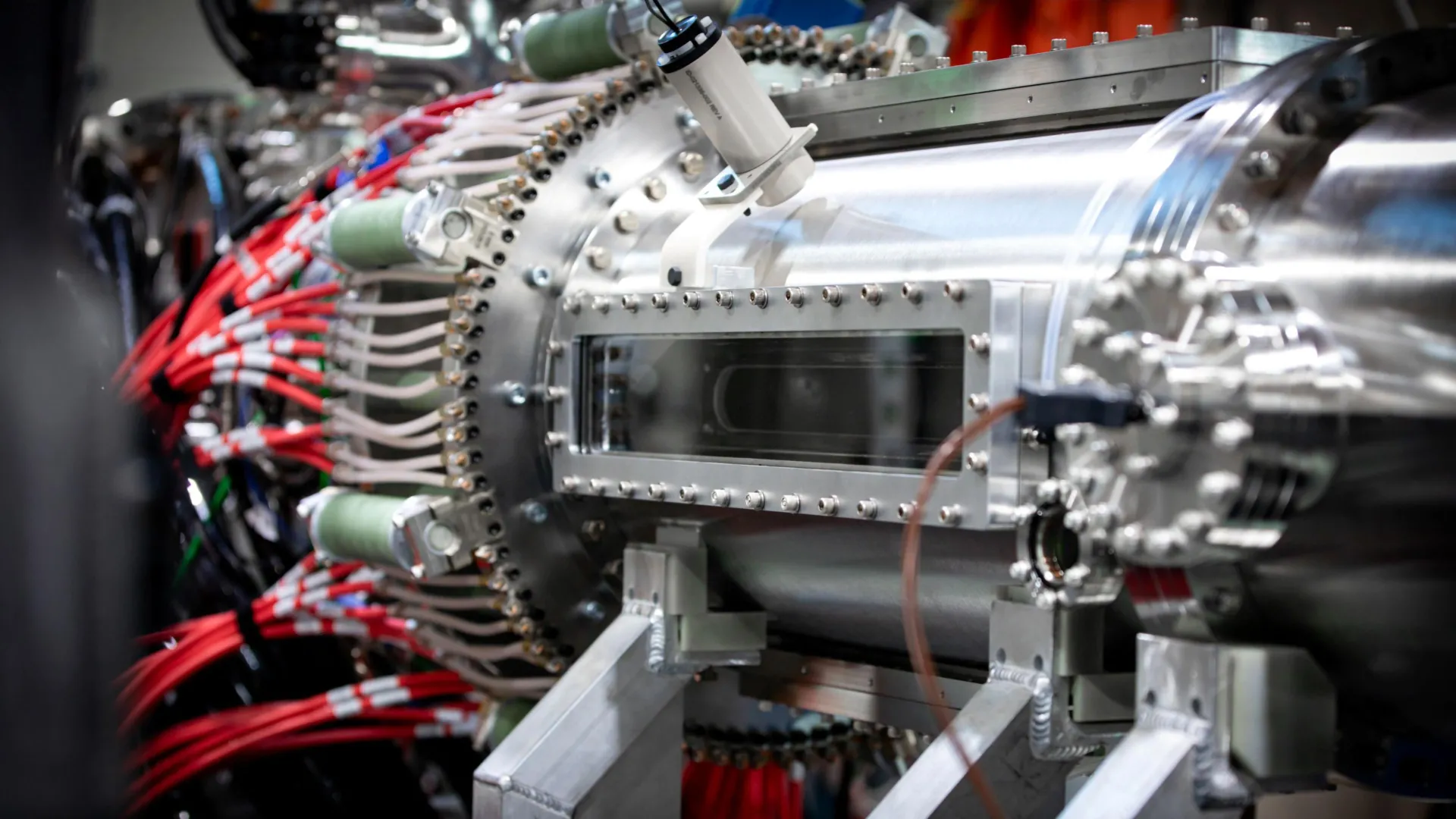A compact fusion machine just hit gigapascal pressures
New generation of fusion device reaches record plasma pressures in a sheared-flow-stabilized Z pinch
- Date:
- November 20, 2025
- Source:
- Zap Energy
- Summary:
- Operating a new device named the Fusion Z-pinch Experiment 3, or FuZE-3, Zap Energy has now achieved plasmas with electron pressures as high as 830 megapascals (MPa), or 1.6 gigapascals (GPa) total, comparable to the pressures found deep below Earth’s crust.
- Share:

Zap Energy has reached a major milestone with its Fusion Z-pinch Experiment 3, known as FuZE-3. The device has generated plasmas with electron pressures up to 830 megapascals (MPa), or a total pressure of 1.6 gigapascals (GPa), a level similar to the intense conditions found deep beneath Earth's crust. This marks the highest pressure ever recorded in a sheared-flow-stabilized Z pinch and represents a significant step toward achieving scientific energy gain, or Q>1.
FuZE-3 is also the first system from Zap to use a third electrode, which allows the mechanisms responsible for accelerating and compressing the plasma to be controlled independently. Early findings were shared during the American Physical Society's Division of Plasma Physics meeting in Long Beach, California.
"There are some big changes in FuZE-3 compared to Zap's previous systems and it's great to see it perform this well so quickly out of the gate," says Colin Adams, Head of Experimental Physics.
Why Extreme Pressure Matters for Fusion
Producing energy from fusion requires plasma that is both extremely hot and extremely dense. Pressure, which reflects both temperature and density, plays a central role because higher pressure allows more fusion reactions to take place. Some fusion systems focus on reaching the highest pressures possible, while others compensate by confining plasma for longer periods. Zap's sheared-flow-stabilized Z pinch seeks a balance between strong compression and sustained confinement.
The team's top single-shot electron pressure measurement so far is 830 MPa. Because plasma contains electrons and much heavier ions, and both are expected to reach similar temperatures, the combined plasma pressure (electrons and ions) is estimated at around 1.6 GPa. To put this in perspective, one gigapascal is roughly ten thousand times the pressure of Earth's atmosphere at sea level, or about ten times the pressure at the bottom of the Mariana Trench.
These pressures were maintained for about a microsecond (one millionth of a second) and measured using optical Thomson scattering, a technique regarded as the most reliable method for determining plasma conditions.
Recent experiments with FuZE-3 have produced multiple repeatable shots with electron densities between 3-5x1024 m-3 and electron temperatures above 1 keV (equal to 21,000,000 degrees Fahrenheit).
"This was a major effort by the team that was successful because of a tightly coupled cycle of theoretical predictions, computational modeling, rapid build and test engineering, experimental validation, and measurement expertise," says Ben Levitt, Vice President of R&D. "With a smaller system we have the benefit of being able to move quickly, and achieving these results in systems that are a fraction of the size and cost of fusion devices of comparable performance is a big part of what makes this such a significant accomplishment."
Designing FuZE-3 for Higher Fusion Performance
FuZE-3 is the third version of the FuZE platform and the fifth sheared-flow-stabilized Z-pinch device that Zap has built. The original FuZE machine, which was the first to reach temperatures above 1 keV, has since been retired. FuZE-Q, which remains in operation, is currently the company's top performer in terms of power and fusion neutron yield.
The goal for FuZE-3 is to reach higher values of the triple product, a key fusion metric that combines density, temperature and confinement time. To support this, the system includes three electrodes and two capacitor banks.
Independent Control of Acceleration and Compression
Earlier Z-pinch tests at Zap relied on a single electrical pulse moving between two electrodes, which required the same power source to both accelerate the plasma to create stabilizing flow and compress it into a Z pinch.
"The capability to independently control plasma acceleration and compression gives us a new dial to tune the physics and increase the plasma density," says Adams. "The two-electrode systems have been effective at heating, but lacked the compression targeted in our theoretical models."
Although the new data show very high pressures, Zap's approach is based on quasi-steady-state magnetic confinement. This is different from inertial fusion systems that rely on intense, nanosecond-long pulses from large arrays of lasers (or in some cases other Z-pinches) to rapidly crush a target. For Zap's method, controlling the stabilizing flow that keeps the plasma well behaved is just as critical as achieving strong compression.
Early Progress and the Push Toward Higher Triple Products
Zap's newest findings from FuZE-3 are still preliminary as the team continues active experimental campaigns. Additional insights are being shared at the APS DPP meeting, and the group intends to publish detailed results in scientific journals in the coming months.
"We're really just getting started with FuZE-3," says Levitt. "It was built and commissioned just recently, we're generating lots of high-quality shots with high repeatability, and we have plenty of headroom to continue making rapid progress in fusion performance. We'll be integrating lessons from FuZE-3 into our next generation systems as we continue advancing toward commercial fusion."
Testing on FuZE-3 will continue while Zap prepares to bring another next generation FuZE device online this winter. Work on future power plant systems is progressing at the same time, supported by the Century demonstration platform.
About Zap Energy
Zap Energy is developing a compact, lower-cost fusion system that confines and compresses plasma without the large and complex magnetic coils used in many other approaches. The company's sheared-flow-stabilized Z-pinch technology promises more favorable fusion economics and requires far less capital than conventional designs. Zap Energy employs 150 people in Seattle and San Diego and is supported by leading strategic and financial investors.
Story Source:
Materials provided by Zap Energy. Note: Content may be edited for style and length.
Cite This Page: